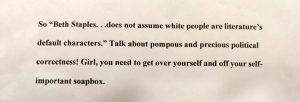Notes from my Self-Important Soapbox
Something that wasn’t on my bucket list this year but actually happened: Shenandoah—nay, I—received my first piece of hate mail.

It arrived in my campus mailbox from San Francisco, of all places. Anonymously. From a person with questionable taste in fonts. A person who—and for this, I’m inclined to like them—bothered to read our submission guidelines. If you’ve read those, you know I try to summarize what I like writing to do. There’s a whole list, and it ends: “and does not assume white people are literature’s default characters.”
Perhaps it’s time to explain what I mean. First of all, let me say that I am white. I want to support writers of all races and genders and sexes and religions and ages and abilities and nationalities and classes (among other qualities), but I certainly fail at this sometimes. I’m trying to be aware of the ways I may be failing, aware of my biases so I can combat them. I’m sure I fail at that too. I want to publish writing that challenges me and our readers and makes all of us think in new ways, and I want to use my position at Shenandoah and Washington and Lee to support writers whose work does that.
To that end, I think it’s important to talk and write and think about race. I don’t think it’s the only thing that should be written about, but I think it’s among the most important things. Race is often difficult to talk and write about, which is precisely why we need to do it more.
I taught a class a few years ago called “Issues of Diversity in Publishing” because I was thinking a lot about the VIDA count and other horrifying statistics. One day my students and I were talking about an article by Marlon James in Literary Hub called “Why I’m Done Talking About Diversity,” wherein James says, about panels on diversity, “why do we need a black person on a panel to talk about inclusion when it’s the white person who needs to figure out how to include?” The article should be read in its entirety, over and over and over. There’s a lot to think about in it, and this quote is just one piece. My students and I started thinking about how this question implicated writers and submissions to literary magazines. Most of the published stories we could think of about race were by writers of color. Most of the stories or books we could think of where characters’ races were even mentioned, it was because those characters were not white. One of my students suggested we go back through the canon and rewrite character descriptions in Dickens, Austen, Joyce (you know, on and on) to acknowledge their whiteness. Wouldn’t that be a fun and sobering exercise? (“It is a truth universally acknowledged, that a single white man in possession of a good fortune, must be in want of a very pasty wife.”)
As James and many others have pointed out, the burden of talking and writing and paneling about race falls on writers of color. And white writers keep on writing their white stories, oblivious, it seems, to the whiteness of their characters. I read a cover letter for a submission just this week that said, “Please excuse the white characters.” And here’s the thing: It’s not the whiteness that’s the problem. It’s the fact that whiteness is usually treated as blankness, a non-issue. After all this time, the whiteness of characters in literary fiction is still mostly implicit, understood. White characters often seem to have no race at all—free to experience the world as if the fact of their whiteness has no real impact on the way they think and behave and are treated. Which of course isn’t true at all. Whiteness is very visible in the world—why shouldn’t it be in our stories?
Look, I know I’m generalizing to a certain extent, and it’s not that I think every story needs to be about race. But with five thousand submissions under my belt in the past eight months, I can tell you that the stories and essays and poems I read about race were not from white writers for the most part. And while most of the submissions we received were about white people, hardly any of them were about whiteness. Racial inequality is not a problem only for people of color. White people—and white characters—need to start reckoning with it too.
I say all this with some trepidation. There are certainly ways to write about race badly, without humility or complexity, to self-congratulate or simply to condemn. The charge is to approach race the same way good writing about white characters has long approached its many other concerns—with the goal of investigating and interrogating the machinations of our hearts and minds as honestly as we can. Though I’ll admit that all sounds terrifying. I certainly don’t want to come across as someone, a white person, who has any of this figured out. As James imagines his all-white panel about diversity, he says, “My fear though is that our absence would create a different set of problems.” I’m not suggesting white writers write about race in place of writers of color, of course. (Shenandoah needs more submissions by writers of color—about race or not at all about race—please submit!) Ultimately, we need stories about race from all kinds of writers, but I think it’s time white writers count themselves among them.
So, thank you, hater from the West Coast, for giving this girl the impulse to sit down and think through what she really means.
—Beth Staples
